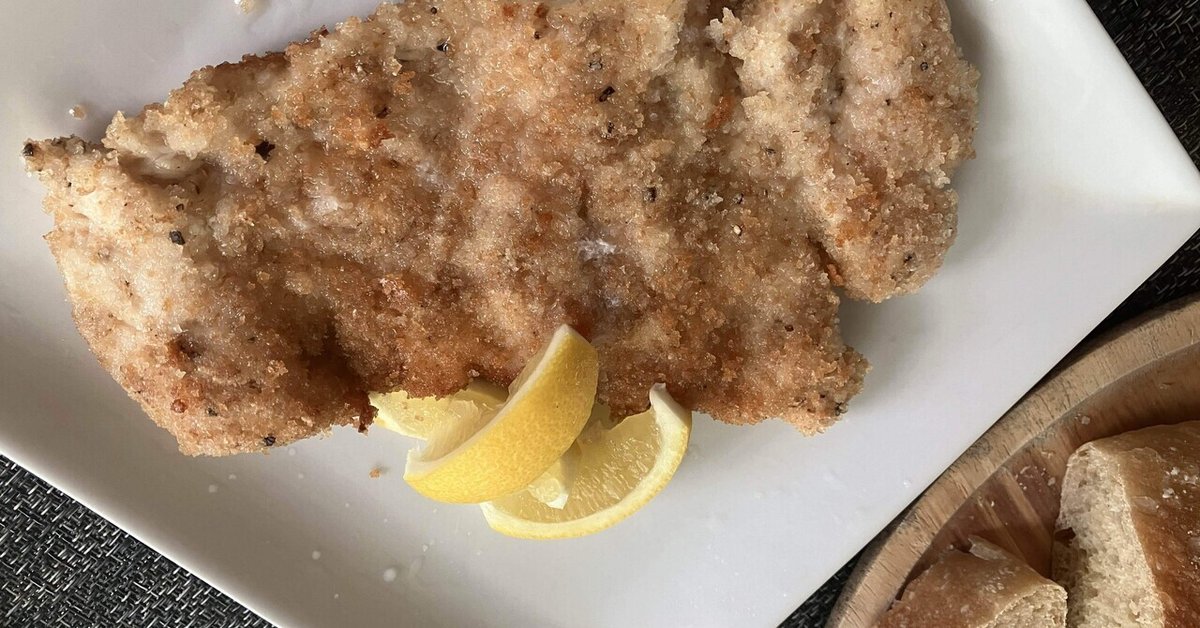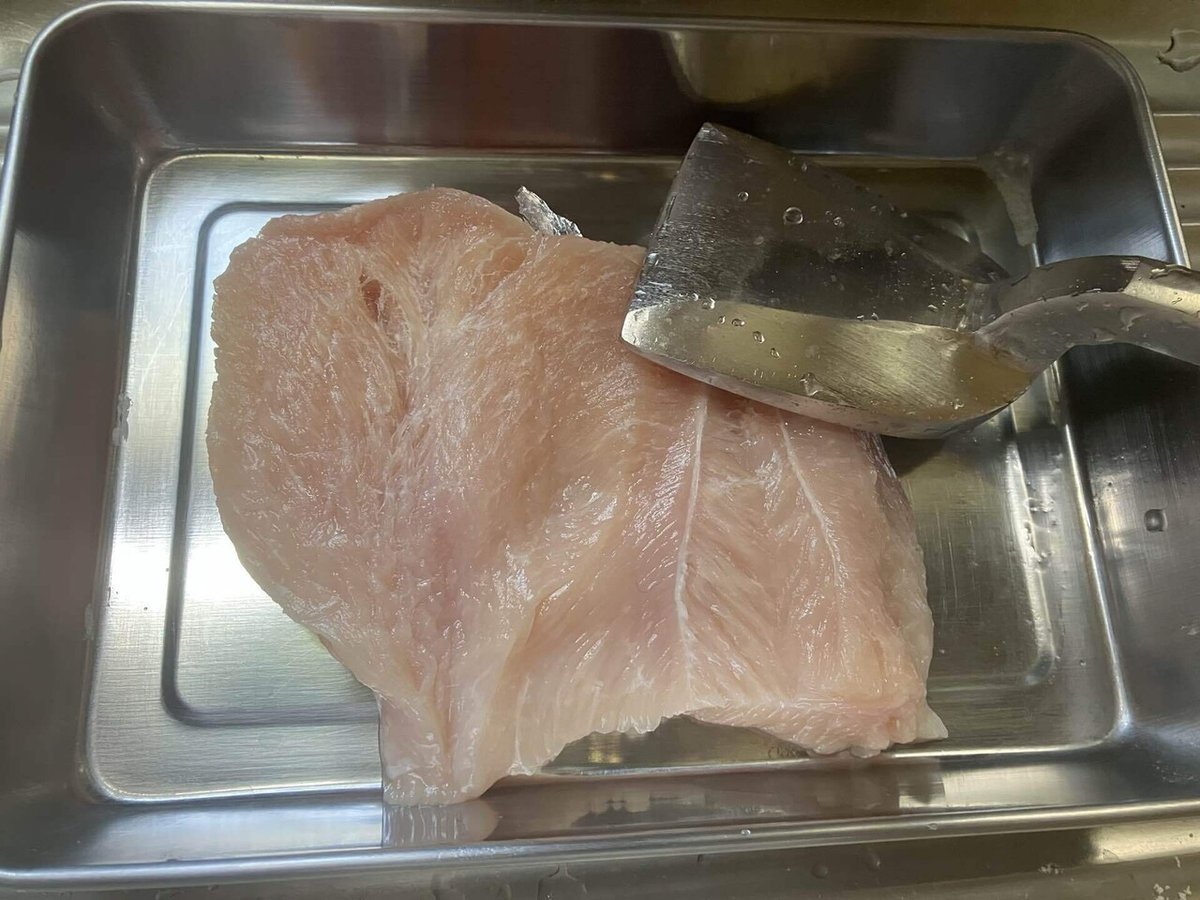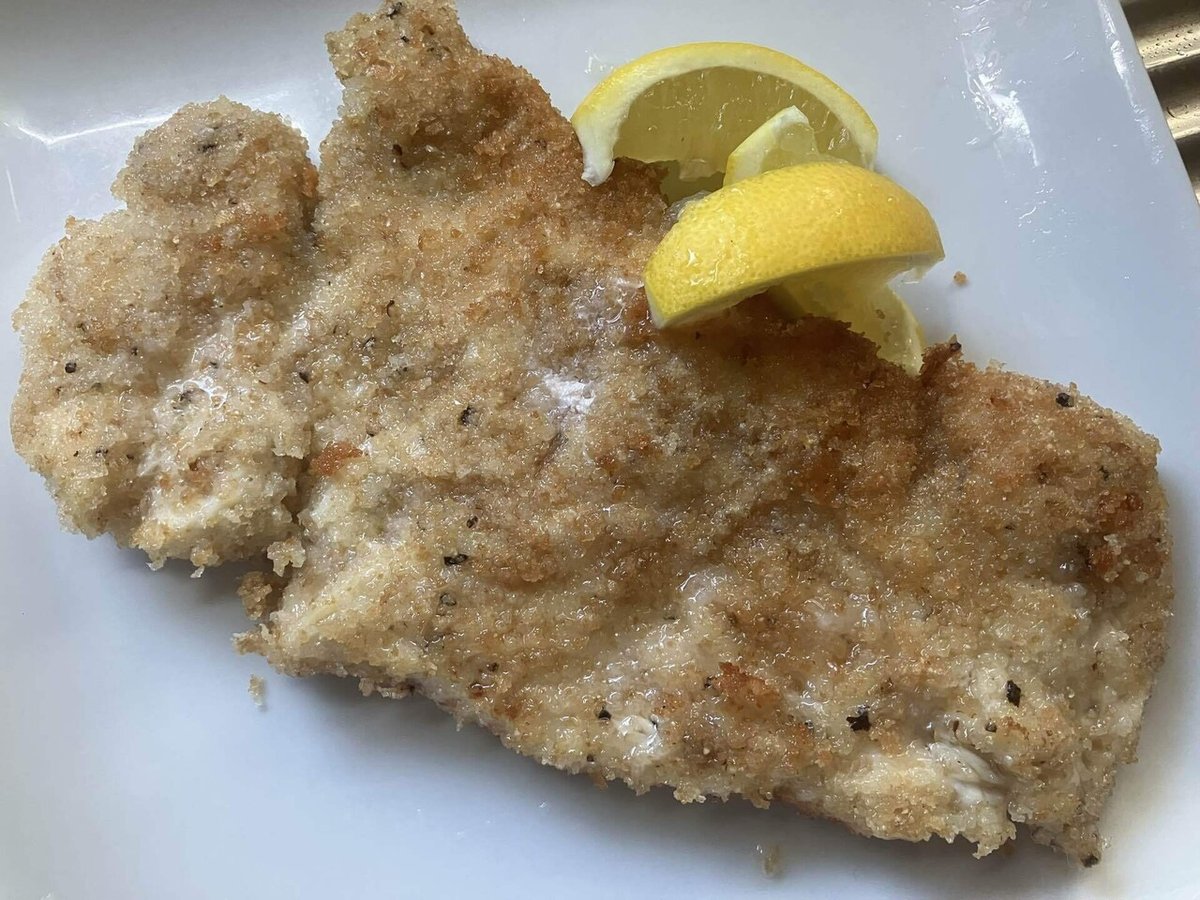
100円で作る貧乏人のシュニッツェル Poor man's schnitzel for 100 yen
貧乏人の歳時記 A minimalist's seasonal calendar
ストーリー
Recipe trivia
「シュニッツェル」は通常は仔牛肉で作る。もちろん僕は貧乏人なので、牛肉は使わない。最安値の肉、鶏むね肉が僕の定番だ。鶏むね肉は日本では2キロ入りのパックでまとめて買うと、税込で800円弱。200グラムが一人前と考えると80円。燃料費や調味料などを含めて100円という計算だ。負け惜しみではないが、鶏胸肉のシュニッツェルは結構美味い。肉質が仔牛肉に近いのだ。どちらも脂がなく、純粋に肉の旨みを楽しむことができる。質の良い仔牛肉は、高い上に、霜降り肉万能の日本ではまず手に入らない。次点は豚のもも肉、やはり脂身が無くシュニッツェルに適している。それでも、鶏肉と比べると結構値が張る。ということで、庶民のたまのご馳走としては、鶏むね肉が唯一の選択肢となる。
"Schnitzel" is usually made with veal. Of course, I don't use beef because I'm poor. My go-to is chicken breast, the cheapest meat. In Japan, if you buy chicken breast in a 2kg pack, it costs just under 800 yen including tax. If you consider 200 grams to be one portion, it's 80 yen. Including fuel costs and seasonings, it works out to 100 yen. I'm not trying to be a sore loser, but chicken breast schnitzel is quite delicious. The meat quality is similar to veal. Both are fat-free, so you can enjoy the pure flavor of the meat. It's hard to find good quality veal in Japan, where marbled meat is all-purpose. The next best is pork thigh, which is also fat-free and suitable for schnitzel. Still, it's quite expensive compared to chicken. So, chicken breast is the only option for an occasional treat for the common people.
鶏のむね肉はぱさぱさして美味しくないと言われる。そのまま焼こうと思うと結構火入れに気を使う。
なぜかと言うと、肉の調理温度を把握しなければならないからだ。肉は摂氏70度台から80度台辺りで急に硬くなり始める。だったら、硬くなる手前で火入れを止めれば良い。その方法論が低温調理だ。低温と言っても、食中毒のリスクもあるし、ある程度火が入ってふっくらするくらいの温度では火を通したい。この火加減が難しいのだ。脂身のない、鶏むね肉、鶏ささみ肉、豚もも肉、豚ヒレ肉は特に難しい。火入れが難しい理由は、肉に厚みがあるからだ。火を中まで通そうとすると、表面が硬くぱさぱさになってしまう。さっと焦げ目だけつけようとすると、中心部は生のままだ(鶏むね肉の火入れのコツは、以前紹介しているので、よければ記事を参照してください)。それで、フライパンなどを使わず、お湯の中で低温で茹でる低温調理方法が考案された。この方法を使ったサラダチキンとか鶏ハムのレシピがたくさん紹介されていて、コンビニでもこの手の商品は人気だ。ただ、この方法だと、香ばしい焦げ目を付けるのが難しい。
テクニックを磨いてフライパンで火入れをしても良いのだが、もう一つの解決方法がある。肉を均等に薄くするのだ。肉が十分に薄ければ、短い時間で均等に火が通る。肉の中心温度を気にしなくても良い道理だ。この方法を使った料理が「シュニッツェル」だ。肉を叩いて薄くし、肉汁が逃げないように衣を付ける。肉に厚みがないので、表裏決まった時間だけ火を通せば良い。しかも肉を叩いて繊維がほぐれているので、ジューシーで柔らかい。油をたくさん使う日本の豚カツと比べ、家庭でも作りやすい。
皿一杯に広がった大きな肉は、とびきりのご馳走感があって、もてなし料理にも使える。
It is said that chicken breast meat is dry and not tasty. If you want to grill it as it is, you have to be careful about how much heat you put in.
The reason is that you need to know the cooking temperature of the meat. Meat starts to become hard suddenly at around 70 to 80 degrees Celsius. So you just need to stop heating it before it gets hard. That methodology is low-temperature cooking. Even though it is low temperature, there is a risk of food poisoning, and you want to cook it at a temperature where it is cooked to a certain extent and becomes plump. This heat control is difficult. It is especially difficult with lean chicken breast meat, chicken tenderloin meat, pork thigh meat, and pork tenderloin. The reason why it is difficult to heat it is because the meat is thick. If you try to heat it all the way through, the surface will become hard and dry. If you try to just brown it quickly, the center will remain raw (I have previously introduced tips on how to heat chicken breast meat, so please refer to the article if you are interested). So a low-temperature cooking method was devised in which the meat is boiled in hot water at a low temperature without using a frying pan or the like. There are many recipes for chicken salad and chicken ham that use this method, and these types of products are popular at convenience stores. However, this method makes it difficult to achieve a nice, fragrant browning.
You can hone your technique and cook the meat in a frying pan, but there is another solution. Cut the meat evenly and thinly. If the meat is thin enough, it will cook evenly in a short amount of time. This means you don't have to worry about the temperature in the center of the meat. A dish that uses this method is "schnitzel." The meat is pounded to make it thin, and then coated with batter to prevent the juices from escaping. Since the meat is not thick, it only needs to be cooked for a set amount of time on both sides. Moreover, the meat is pounded to break up the fibers, so it is juicy and tender. Compared to Japanese pork cutlets, which require a lot of oil, it is easier to make at home.
The large piece of meat spread across the plate feels like an exquisite feast and can also be used as a dish to entertain guests.
「シュニッツェル(Schnitzel / Schnitzerl)」はドイツ語で、ドイツ語圏を中心に食べられている。どうやら西ローマ帝国の版図に広がった歴史を持つらしく、東欧や中東でも食べられている。イタリア北部の「ミラノ風カツレツ」も同じ作り方で、その関連を想起させる。伝統的には、仔牛肉を使うのだけど、庶民の料理としては、豚肉、羊肉、鶏肉も使われる。ここでは「ウイーン風シュニッツェル」の作り方で、鶏のむね肉を使ったレシピを紹介する。
"Schnitzel (Schnitzerl)" is a German word and is eaten mainly in German-speaking countries. It seems to have a history of spreading throughout the territory of the Western Roman Empire, and is also eaten in Eastern Europe and the Middle East. Milanese cutlets in northern Italy are made in the same way, evoking a connection. Traditionally, veal is used, but pork, lamb, and chicken are also used in popular dishes. Here we will introduce a recipe for making Viennese schnitzel using chicken breast.
Ingredients:
材料:
鶏むね肉
卵
牛乳
自家製パン粉(市販のもので良い。グルテンフリーならば米粉のパン粉を使うと良い)
レモン
マジョラム
自然塩
胡椒
酸化しにくい油(バターやラードでも良い)
Chicken breast
Egg
Milk
Homemade breadcrumbs (store-bought breadcrumbs are fine, but if you're gluten-free, rice flour breadcrumbs are a good choice)
Lemon
Marjoram
Salt
Pepper
Oil that won't oxidize easily (butter or lard are fine too)
procedure:
手順:
鶏むね肉を一人前の塊に切り出し、繊維に沿った方向に包丁を入れて薄く開く。
開いた肉をガラス瓶などで叩いてさらに薄くする(五ミリ厚くらい)。肉叩きがあれば、なお良い。
肉の表面に塩胡椒を振り、小麦粉(または米粉)をまぶしておく。
パン粉にマジョラムを混ぜておく。
牛乳と卵を溶き、肉を浸して、満遍なくパン粉をまぶす。
フライパンを十分に熱し(テフロン加工の場合は不要)、1センチくらいの深さに油を敷く。
油が熱くなったら、中火にして肉を入れ、焦げ目がついたら(2分くらいが目安)、裏も同様に火を通す。
肉の油をよく切って、さらに盛り付け、レモンを添える。
Cut the chicken breast into individual portions and cut it in the direction of the grain to thinly slice it.
Beat the cut meat with a glass bottle or something similar to make it even thinner (to about 5mm thick). If you have a meat tenderizer, it's even better.
Sprinkle salt and pepper on the surface of the meat, and coat it with flour (or rice flour).
Mix marjoram into the breadcrumbs.
Beat the milk and egg, then soak the meat in it and coat it evenly with the breadcrumbs.
Heat a frying pan thoroughly (not necessary if using a Teflon-coated pan), and add oil to a depth of about 1cm.
Once the oil is hot, turn the heat to medium and add the meat. Once it is browned (about 2 minutes is a good rule of thumb), cook the other side in the same way.
Drain the oil well and serve on a plate, garnished with lemon.











Tips and tricks:
コツと応用のヒント:
鶏むね肉をぱさぱさにしない下ごしらえのコツは、切り方。必ず繊維に沿った方向に包丁を入れて、削ぐように開くべきだ。繊維を断ち切って壊してしまうと、そこから肉汁が流れて、旨みが失われてしまう。よく逆のことを書いてあるレシピに遭遇する。確かに繊維を壊してしまえば、繊維が硬くなるのを緩和できる。ただ、その方法では、肉汁が流れ出してしまって味がなくなり、繊維の噛みごたえもないために、ぱさぱさかつもさもさの食感になってしまう。
ビール瓶など適当な瓶を使って叩いても良いけど、扁平で重たい肉叩きを使うと、綺麗に伸ばすことができるので、よく肉の塊を焼く人にはおすすめ。
ここでは、卵と牛乳を使っているけど、卵だけ、牛乳だけ、あるいは豆乳などを使っても良い。水でも構わないが、牛乳や豆乳を使った方が綺麗な揚げ色がつく。
肉を五ミリくらいに延ばしてあると、片面1、2分で十分火が通るので、それ以上の加熱は不要。
衣にマジョラムを入れているが、似た風味のオレガノで代用しても良い。ミラノ風にするなら、パルメザンチーズを衣と混ぜる。
ウイーン風はシンプルにレモンを絞っただけで、肉の味を楽しむが、ソースをかけても良い。キノコ入りのドミグラソースを添えれば、「木こり風シュニッツェル」となる。グレービーソースやベシャメルソースを添えたシュニッツェルも見たことがある。
日本の安っぽいソースをかけてキャベツと和芥子を添えれば、いわゆる「紙カツ」になる。大きめのパンに挟んでカツサンドにしたり、カツカレーに仕立てるのも、日本的B級グルメとしては、全然ありだ。
The trick to preparing chicken breast so that it doesn't become dry is how you cut it. You should always cut along the grain of the meat, and slice it open. If you cut through the grain and break it, the juices will leak out and the flavor will be lost. I often come across recipes that say the opposite. It's true that breaking the grain can help prevent it from becoming hard. However, this method will cause the juices to leak out and the flavor to be lost, and the grains will not have a chewy texture, so it will become dry and chewy.
You can use a beer bottle or other suitable bottle to beat the meat, but if you use a flat, heavy meat beater, you can stretch it out nicely, so it's recommended for people who often grill large chunks of meat.
Here, eggs and milk are used, but you can also use just eggs, just milk, or soy milk. Water is fine, but milk or soy milk will give it a nice fried color.
If the meat is stretched out to about 5 mm, it will be cooked sufficiently in 1-2 minutes on each side, so no further heating is necessary.
The batter contains marjoram, but oregano, which has a similar flavor, can be used instead. For the Milanese style, mix Parmesan cheese into the batter.
The Viennese style is simply topped with a squeeze of lemon to enjoy the flavor of the meat, but you can also add sauce. If you add a mushroom demi-glace sauce, it becomes a "lumberjack-style schnitzel." I've also seen schnitzel with gravy or béchamel sauce.
If you top it with a cheap Japanese sauce and garnish it with cabbage and Japanese mustard, it becomes what is known as "paper cutlet." It's also perfectly acceptable to make a cutlet sandwich by putting it between large pieces of bread, or to make a cutlet curry, as Japanese B-class gourmet food.
写真は自家製のライ麦パンを添えたもの。
The photo shows it served with homemade rye bread.

Guide to where to get ingredients and equipment 材料と機材の入手先ガイド
※Amazonのアフェリエイトに参加しています。もしご購入の際はここからクリックしてご購入いただけると、コーヒー代の足しになるので、嬉しいです。ちなみに僕はコーヒー依存症です。
*I participate in Amazon affiliate programs. If you purchase this product by clicking here, it will help pay for my coffee, so I would be very happy. By the way, I am addicted to coffee.
この記事が気に入ったらサポートをしてみませんか?
